Operational Modal Analysis of Offshore Wind Turbine Tower under Ambient Excitation
Abstract
:1. Introduction
2. Modal Parameter Identification from Ambient Vibration
2.1. Kalman Filter
2.2. Random Decrement Technique
2.3. Stochastic Subspace Identification
3. Experimental Investigation
3.1. Experimental Setup
3.2. Verification of the RDT-SSI Method
3.3. Influence of Embedment Depth
3.4. Influence of Blade Bolt Loosening
4. Concluding Remarks
- (1)
- The proposed RDT-SSI method can effectively identify the first-order modal parameters of the OWT subjected to unknown ambient excitation.
- (2)
- The operational modal parameters are sensitive to damage to the structure. The frequency decreased when the blades of the turbine were loosened due to long-term functioning. Therefore, the first-order frequency can be employed as an early-stage warning of structural damage.
- (3)
- The experimental results confirmed that when the embedment depth of the foundation was reduced due to the scouring phenomenon, the frequency of the OWT decreased. This is because the scouring weakens the constraint of the structure and, thus, increases the flexibility of the structure. Therefore, the first-order frequency can also be used as a reference for the scouring intensity.
Author Contributions
Funding
Institutional Review Board Statement
Informed Consent Statement
Data Availability Statement
Conflicts of Interest
Nomenclature
| Parameter | Description |
| Mass matrix | |
| Damping matrix | |
| Stiffness matrix | |
| External excitation | |
| Displacement vector | |
| Velocity | |
| Acceleration | |
| State vectors | |
| Output vectors | |
| State matrix | |
| Gating matrix | |
| Output matrix | |
| Transfer matrix | |
| Kalman Filtering | |
| Measurement result | |
| Process noise | |
| Measurement noise | |
| , , | A time unit |
| State variable to measurement conversion matrix | |
| The covariance matrix of the process noise | |
| The covariance matrix of the measurement noise | |
| Priori state estimate at time K | |
| Posterior estimate | |
| Posteriori state estimate at time K | |
| Kalman filter gain | |
| Posteriori estimate error | |
| Priori estimate error | |
| Priori estimate error covariance | |
| Posteriori estimate error covariance | |
| Mathematic expectation | |
| RDT | |
| Initial displacement | |
| Unit impulse response function | |
| Initial velocity | |
| The free vibration response of the displacement with an initial displacement of 1 and initial velocity of 0 | |
| The free vibration response of velocity | |
| The self-vibration frequency of damping system | |
| Damping ratio | |
| Phase angle | |
| Constant | |
| SSI | |
| Hankel matrix | |
| Discrete collection points | |
| The response of measurement point at the time i | |
| The output of the past | |
| The output of the past | |
| The output of the “future” | |
| The output of the “future” | |
| QR decomposition | |
| Projection matrix | |
| SVD decomposition result | |
| Observability matrix | |
| Kalman filter state sequence | |
| Mode shapes | |
| Diagonal matrix | |
| System eigenvector matrix | |
| Eigenvalue | |
| System frequency | |
References
- Lian, J.; Cai, O.; Dong, X.; Jiang, Q.; Zhao, Y. Health Monitoring and Safety Evaluation of the Offshore Wind Turbine Structure: A Review and Discussion of Future Development. Sustainability 2019, 11, 494. [Google Scholar] [CrossRef] [Green Version]
- Park, G.; You, D.; Oh, K.; Nam, W. Natural Frequency Degradation Prediction for Offshore Wind Turbine Structures. Machines 2022, 10, 356. [Google Scholar] [CrossRef]
- Global Wind Energy Council. Global Wind Statistics 2021. Global Statistics. Available online: https://gwec.net/global-wind-report-2022/ (accessed on 1 June 2022).
- Ishihara, T.; Yamaguchi, A.; Takahara, K.; Mekaru, T.; Matsuura, S. An Analysis of Damaged Wind Turbines by Typhoon Maemi in 2003. Proceeding of APCWE VI 2005; pp. 1413–1428. Available online: http://windeng.t.u-tokyo.ac.jp/ishihara/e/proceedings/2005-7_paper.pdf (accessed on 1 April 2022).
- Chen, X.; Xu, J.Z. Structural failure analysis of wind turbines impacted by super typhoon Usagi. Eng. Fail. Anal. 2016, 60, 391–404. [Google Scholar] [CrossRef]
- Chou, J.; Ou, Y.; Lin, K.; Wang, Z. Structural failure simulation of onshore wind turbines impacted by strong winds. Eng. Struct. 2018, 162, 257–269. [Google Scholar] [CrossRef]
- Lou, C. Study on the Design of Simple Offshore Wind Turbine Foundation. Master’s Thesis, Dalian University of Technology, Dalian, China, 2017. [Google Scholar]
- Ye, K.; Li, C.; Yang, Y.; Zhang, W.; Xu, Z. Research on influence of ice-induced vibration on offshore wind turbines. J. Renew. Sustain. Energy 2019, 11, 33301. [Google Scholar] [CrossRef]
- Liu, J.; Guo, Z.; Zhu, N.; Zhao, H.; Garg, A.; Xu, L.; Liu, T.; Fu, C. Dynamic Response of Offshore Open-Ended Pile under Lateral Cyclic Loadings. J. Mar. Sci. Eng. 2019, 7, 128. [Google Scholar] [CrossRef] [Green Version]
- Ernst, B.; Seume, J.R. Investigation of Site-Specific Wind Field Parameters and Their Effect on Loads of Offshore Wind Turbines. Energies 2012, 5, 3835–3855. [Google Scholar] [CrossRef] [Green Version]
- Márquez-Domínguez, S.; Sørensen, J.D. Fatigue Reliability and Calibration of Fatigue Design Factors for Offshore Wind Turbines. Energies 2012, 5, 1816–1834. [Google Scholar] [CrossRef] [Green Version]
- Tchakoua, P.; Wamkeue, R.; Ouhrouche, M.; Slaoui-Hasnaoui, F.; Tameghe, T.; Ekemb, G. Wind Turbine Condition Monitoring: State-of-the-Art Review, New Trends, and Future Challenges. Energies 2014, 7, 2595–2630. [Google Scholar] [CrossRef] [Green Version]
- Yang, W.; Tavner, P.J.; Crabtree, C.J.; Feng, Y.; Qiu, Y. Wind turbine condition monitoring: Technical and commercial challenges. Wind Energy 2014, 17, 673–693. [Google Scholar] [CrossRef]
- Sinha, Y.; Steel, J.A. A progressive study into offshore wind farm maintenance optimisation using risk based failure analysis. Renew. Sustain. Energy Rev. 2015, 42, 735–742. [Google Scholar] [CrossRef]
- Schubel, P.J.; Crossley, R.J.; Boateng, E.; Hutchinson, J.R. Review of structural health and cure monitoring techniques for large wind turbine blades. Renew. Energy 2013, 51, 113–123. [Google Scholar] [CrossRef]
- Yang, B.; Sun, D. Testing, inspecting and monitoring technologies for wind turbine blades: A survey. Renew. Sustain. Energy Rev. 2013, 22, 515–526. [Google Scholar] [CrossRef]
- Wymore, M.L.; Van Dam, J.E.; Ceylan, H.; Qiao, D. A survey of health monitoring systems for wind turbines. Renew. Sustain. Energy Rev. 2015, 52, 976–990. [Google Scholar] [CrossRef]
- Martinez-Luengo, M.; Kolios, A.; Wang, L. Structural health monitoring of offshore wind turbines: A review through the Statistical Pattern Recognition Paradigm. Renew. Sustain. Energy Rev. 2016, 64, 91–105. [Google Scholar] [CrossRef] [Green Version]
- Salameh, J.P.; Cauet, S.; Etien, E.; Sakout, A.; Rambault, L. Gearbox condition monitoring in wind turbines: A review. Mech. Syst. Signal Process. 2018, 111, 251–264. [Google Scholar] [CrossRef]
- Hameed, Z.; Hong, Y.S.; Cho, Y.M.; Ahn, S.H.; Song, C.K. Condition monitoring and fault detection of wind turbines and related algorithms: A review. Renew. Sustain. Energy Rev. 2009, 13, 1–39. [Google Scholar] [CrossRef]
- Bang, H.J.; Kim, H.I.; Lee, K.S. Measurement of Strain and Bending Deflection of a Wind Turbine Tower Using Arrayed FBG Sensors. Int. J. Precis. Eng. Manuf. 2012, 13, 2121–2126. [Google Scholar] [CrossRef]
- Tang, J.; Soua, S.; Mares, C.; Gan, T. A Pattern Recognition Approach to Acoustic Emission Data Originating from Fatigue of Wind Turbine Blades. Sensors 2017, 17, 2507. [Google Scholar] [CrossRef] [Green Version]
- Li, Y.; Shen, H.; Guo, W. Simulation and Experimental Study on the Ultrasonic Micro-Vibration De-Icing Method for Wind Turbine Blades. Energies 2021, 14, 8246. [Google Scholar] [CrossRef]
- Raišutis, R.; Tiwari, K.A.; Žukauskas, E.; Tumšys, O.; Draudvilienė, L. A Novel Defect Estimation Approach in Wind Turbine Blades Based on Phase Velocity Variation of Ultrasonic Guided Waves. Sensors 2021, 21, 4879. [Google Scholar] [CrossRef]
- Zheng, M.; Shen, F.; Chen, H. Operational modal analysis schemes using correlation technique. Acta Mech. Solida Sin. 2005, 18, 88–94. [Google Scholar]
- Peeters, B.; De Roeck, G. Stochastic System Identification for Operational Modal Analysis: A Review. J. Dyn. Syst. Meas. Control. 2001, 123, 659–667. [Google Scholar] [CrossRef]
- Brincker, R.; Ventura, C. Introduction to Operational Modal Analysis; John Wiley & Sons: Hoboken, NJ, USA, 2015. [Google Scholar]
- Bin Zahid, F.; Ong, Z.C.; Khoo, S.Y. A review of operational modal analysis techniques for in-service modal identification. J. Braz. Soc. Mech. Sci. Eng. 2020, 42, 398. [Google Scholar] [CrossRef]
- Rainieri, C.; Fabbrocino, G. Operational Modal Analysis of Civil Engineering Structures; Springer: New York, NY, USA, 2014. [Google Scholar]
- Hu, W.; Tang, D.; Wang, M.; Liu, J.; Li, Z.; Lu, W.; Teng, J.; Said, S.; Rohrmann, R.G. Resonance Monitoring of a Horizontal Wind Turbine by Strain-Based Automated Operational Modal Analysis. Energies 2020, 13, 579. [Google Scholar] [CrossRef] [Green Version]
- Dolinski, L.; Krawczuk, M. Analysis of Modal Parameters Using a Statistical Approach for Condition Monitoring of the Wind Turbine Blade. Appl. Sci. 2020, 10, 5878. [Google Scholar] [CrossRef]
- Pacheco, J.; Oliveira, G.; Magalhães, F.; Moutinho, C.; Cunha, Á. Vibration-Based Monitoring of Wind Turbines: Influence of Layout and Noise of Sensors. Energies 2021, 14, 441. [Google Scholar] [CrossRef]
- Kim, H.C.; Kim, M.H.; Choe, D.E. Structural health monitoring of towers and blades for floating offshore wind turbines using operational modal analysis and modal properties with numerical-sensor signals. Ocean. Eng. 2019, 188, 106226. [Google Scholar] [CrossRef]
- Cole, J.H. On-the-line analysis of random vibration. In Proceedings of the 9th Structural Dynamics and Materials Conference, Palm Springs, CA, USA, 1–3 April 1968. [Google Scholar]
- Ibrahim, S. The use of random decrement technique for identification of structural modes of vibration. In Proceedings of the 18th Structural Dynamics and Materials Conference, San Diego, CA, USA, 21–23 March 1977. [Google Scholar]
- Vandiver, J.K.; Dunwoody, A.B.; Campbell, R.B.; Cook, M.F. A mathematical basis for the random decrement vibration signature analysis technique. J. Mech. Des. 1982, 104, 307–313. [Google Scholar] [CrossRef]
- Asmussen, J.C. Modal Analysis Based on the Random Decrement Technique; Department of Mechanical Engineering, Aalborg University: Aalborg, Denmark, 1997. [Google Scholar]
- Brincker, R.; Amador, S. On the theory of random decrement. Mech. Syst. Signal Process. 2022, 173, 109060. [Google Scholar] [CrossRef]
- Vesterholm, K.K.; Brincker, R.; Brandt, A. Random decrement technique for detection and characterization of nonlinear behavior. Mech. Syst. Signal Process. 2020, 143, 106841. [Google Scholar] [CrossRef]
- Vesterholm, K.K.; Brincker, R.; Brandt, A. Some Aspects of Using the Random Decrement Technique for Nonlinear Systems. Nonlinear Struct. Syst. 2022, 1, 39–41. [Google Scholar]
- Silva, E.; Magluta, C.; Roitman, N.; Filho, L.A. Development of a structural identification methodology with uncertainty quantification through the SSI and bootstrap techniques. Mech. Syst. Signal Process. 2022, 165, 108290. [Google Scholar] [CrossRef]
- Rodrigues, J.; Brincker, R. Application of the Random Decrement Technique in Operational Modal Analysis. Biomed. Eng. Online 2005. Available online: https://vbn.aau.dk/ws/files/12812147/Application_of_the_Random_Decrement_Technique_in_Operational_Modal_Analysis (accessed on 1 June 2022).
- Siebel, T.; Friedmann, A.; Koch, M.; Mayer, D. Assessment of mode shape-based damage detection methods under real operational conditions. In Proceedings of the Proceedings of the 6th European Workshop on Structural Health Monitoring, Dresden, Germany, 3–6 July 2012. [Google Scholar]
- Mieloszyk, M.; Ostachowicz, W. An application of Structural Health Monitoring system based on FBG sensors to offshore wind turbine support structure model. Mar. Struct. 2017, 51, 65–86. [Google Scholar] [CrossRef]
- Ou, Y.; Tatsis, K.E.; Dertimanis, V.K.; Spiridonakos, M.D.; Chatzi, E.N. Vibration-based monitoring of a small-scale wind turbine blade under varying climate conditions. Part I: An experimental benchmark. Struct. Control. Health Monit. 2021, 28, e2660. [Google Scholar] [CrossRef]
- Lorenzo, E.D.; Wang, L.-Z.; Guo, Z.; Bhattacharya, S.; Nikitas, G.; Li, L.-L.; Xing, Y.-L. Damage detection in wind turbine blades by using operational modal analysis. Struct. Health Monit. 2016, 15, 289–301. [Google Scholar] [CrossRef]
- Yu, L.Q.; Wang, L.Z.; Guo, Z.; Bhattacharya, S.; Nikitas, G.; Li, L.L.; Xing, Y.L. Long-term dynamic behavior of monopile supported offshore wind turbines in sand. Theor. Appl. Mech. Lett. 2015, 5, 80–84. [Google Scholar] [CrossRef] [Green Version]
- Maybeck, P.S. Stochastic Models, Estimation, and Control; Academic Press: Cambridge, MA, USA, 1982. [Google Scholar]
- Dong, X.; Lian, J.; Yang, M.; Wang, H. Operational modal identification of offshore wind turbine structure based on modified stochastic subspace identification method considering harmonic interference. J. Renew. Sustain. Energy 2014, 6, 033128. [Google Scholar] [CrossRef]
- Zarbaf, S.E.H.A.M.; Norouzi, M.; Allemang, R.J.; Hunt, V.J.; Helmicki, A.; Nims, D.K. Stay Force Estimation in Cable-Stayed Bridges Using Stochastic Subspace Identification Methods; American Society of Civil Engineers: New York, NY, USA, 2017. [Google Scholar]
- Zhou, X.; Cao, L.; Khan, I.; Li, Q. Data inspecting and denoising method for data-driven stochastic subspace identification. Shock Vib. 2018, 2018, 3926817. [Google Scholar] [CrossRef] [Green Version]
- Novak, M.; Nogami, T. Soil-pile interaction in horizontal vibration. Earthq. Eng. Struct. Dyn. 1977, 5, 263–281. [Google Scholar] [CrossRef]
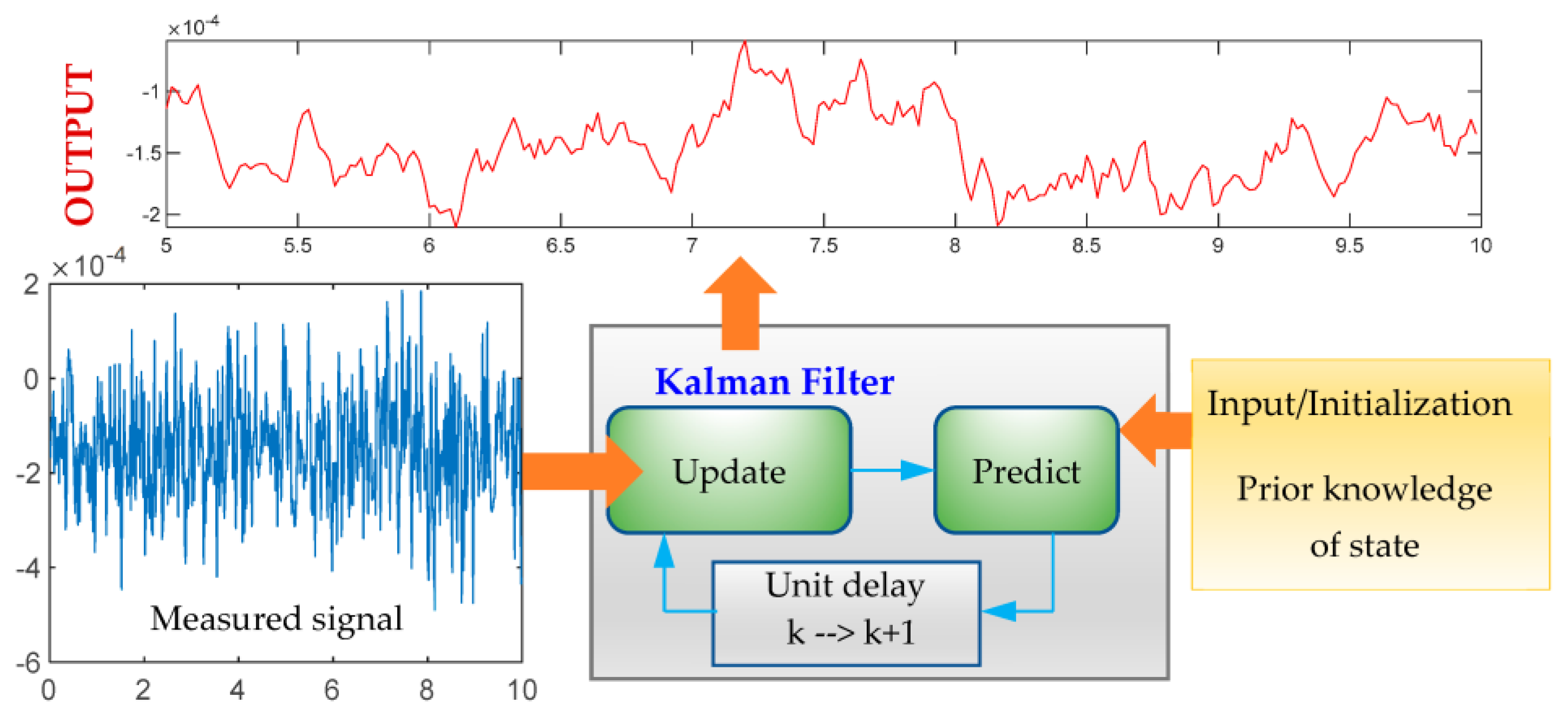
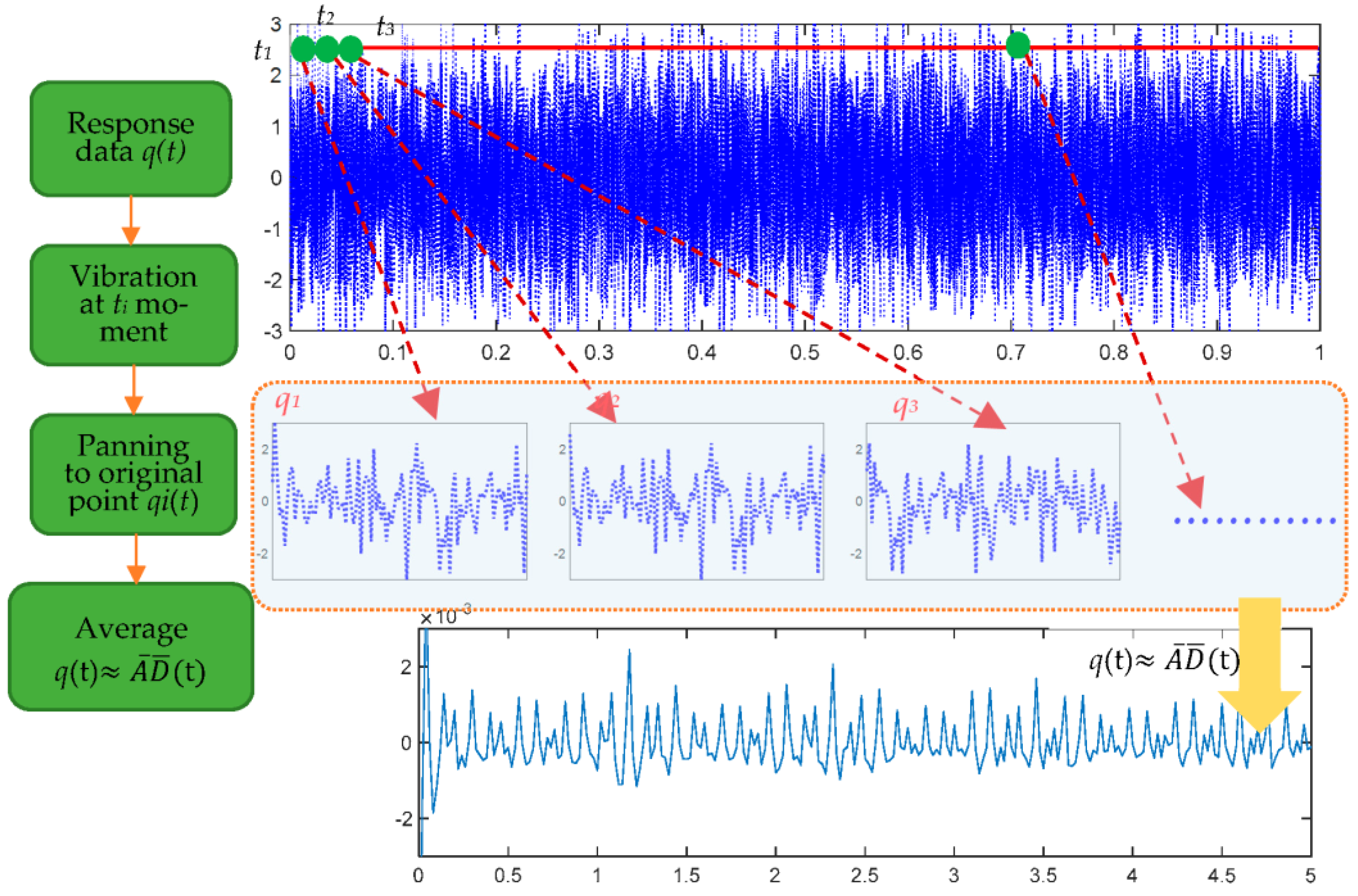
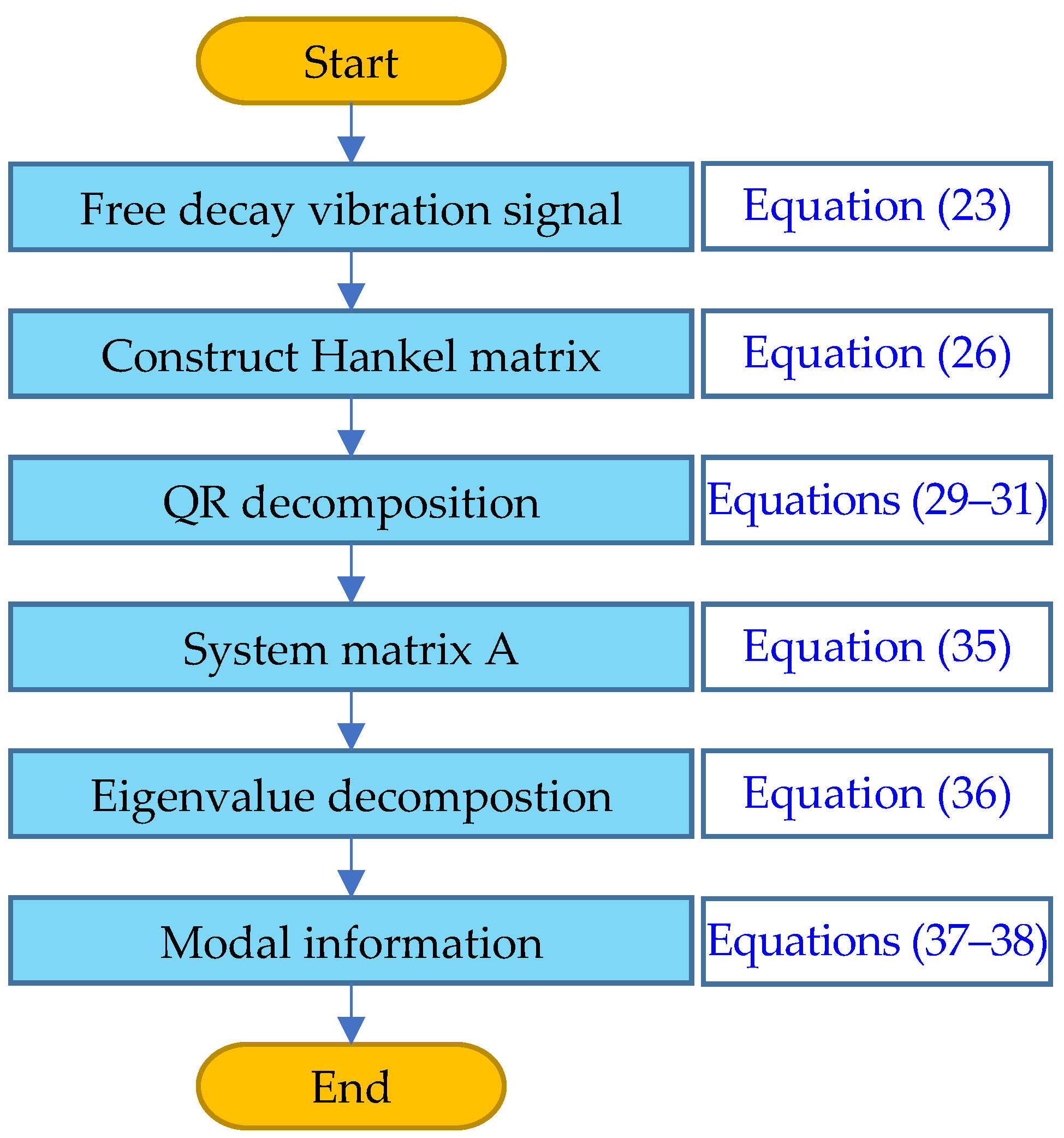


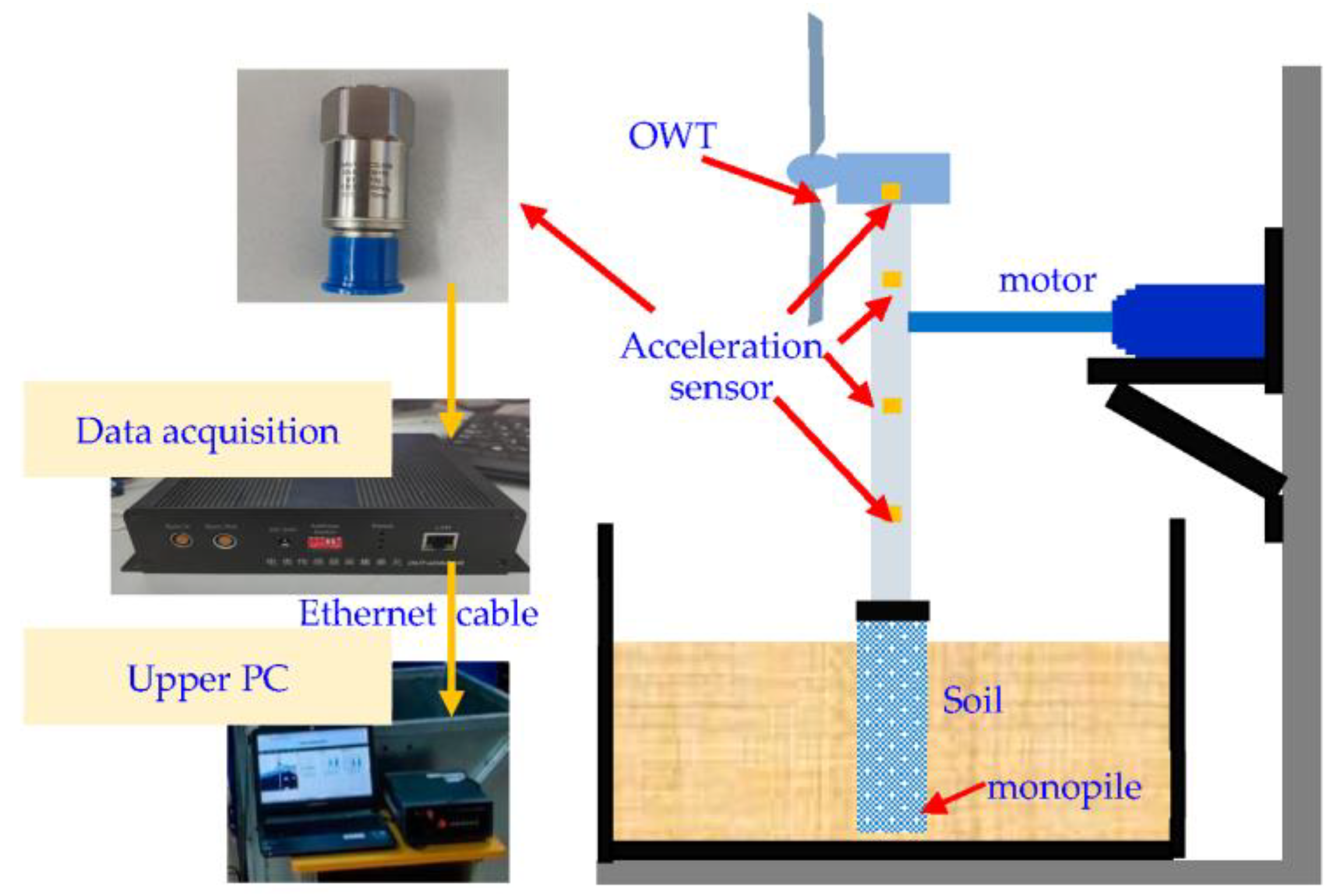



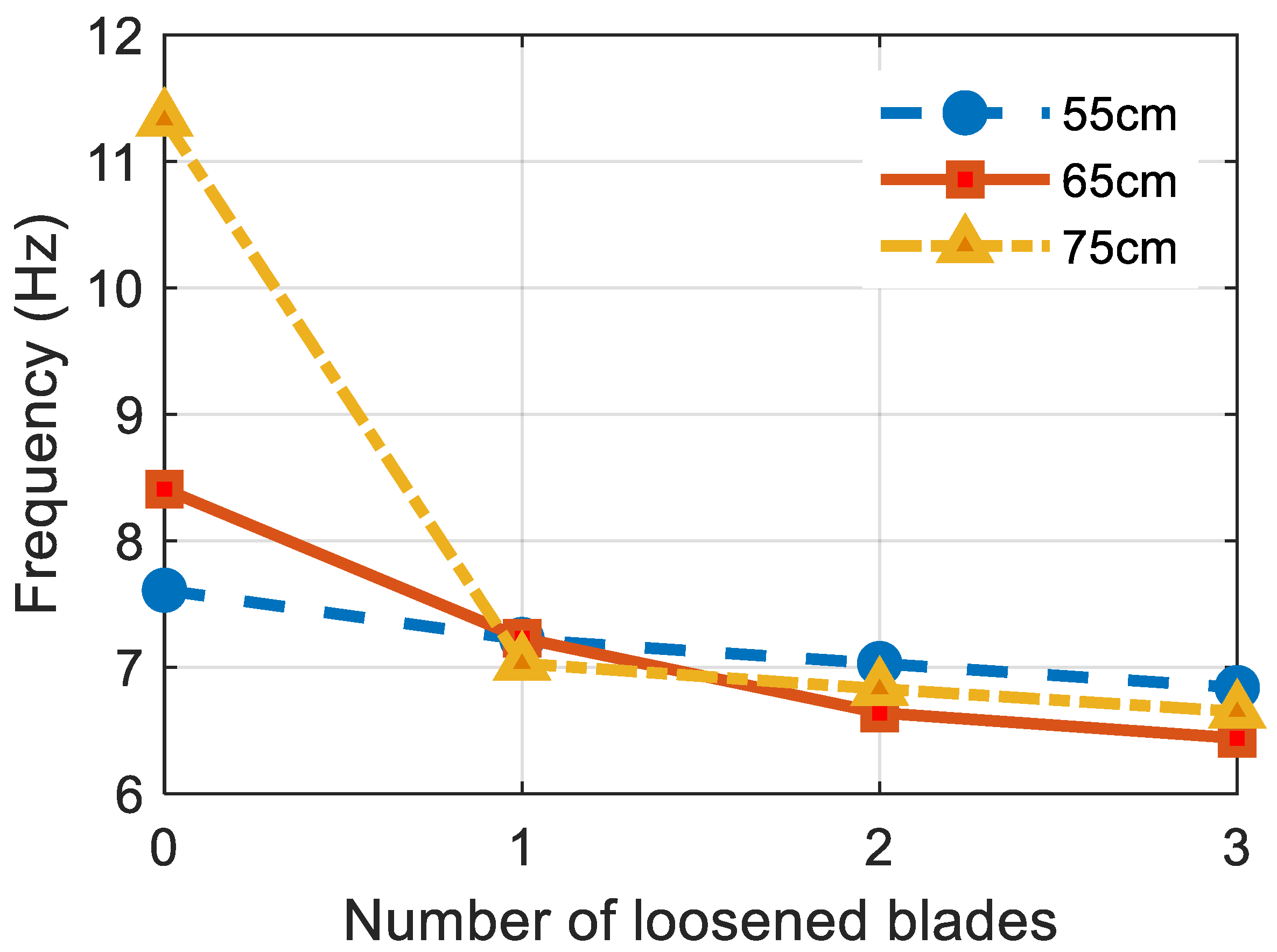
| Max. Lateral Sensitivity | 5% | Constant-Current Source | +2 mA~+10 mA |
| Sensitivity | 499 mv/g | Bias Voltage | 13.1 V |
| Frequency Response | 0.6~5 K (±10%) 0.3~7 K (±3dB) | Working Temperature | −40~+120 °C |
| Weight | ~100 g | Temperature Coefficient | +0.11%/°C |
| Measurement Range | ±10 g | Polarity | + |
| Working Voltage | +24 V~+36 V |
| Model | DUT-Edaq-U8 | DC Input Voltage | 24 V |
| Measurement Channels | 8 | AC Input Voltage | 220 V |
| Sample Rate | 400 Hz | Ambient Temperature | −20 °C~+55 °C |
| Embedment Depth | Number of Loosened Blades | Average Frequency (Hz) | Variance (Hz) |
|---|---|---|---|
| 55 cm | 0 | 7.61 | 0.0050 |
| 1 | 7.22 | 0.0002 | |
| 2 | 7.03 | 0.0030 | |
| 3 | 6.84 | 0.0072 | |
| 65 cm | 0 | 8.41 | 0.0004 |
| 1 | 7.23 | 0.0017 | |
| 2 | 6.64 | 0.0026 | |
| 3 | 6.44 | 0.0062 | |
| 75 cm | 0 | 11.33 | 0.0023 |
| 1 | 7.03 | 0.0007 | |
| 2 | 6.83 | 0.0020 | |
| 3 | 6.65 | 0.0939 |
Publisher’s Note: MDPI stays neutral with regard to jurisdictional claims in published maps and institutional affiliations. |
© 2022 by the authors. Licensee MDPI, Basel, Switzerland. This article is an open access article distributed under the terms and conditions of the Creative Commons Attribution (CC BY) license (https://creativecommons.org/licenses/by/4.0/).
Share and Cite
Zhang, P.; He, Z.; Cui, C.; Ren, L.; Yao, R. Operational Modal Analysis of Offshore Wind Turbine Tower under Ambient Excitation. J. Mar. Sci. Eng. 2022, 10, 1963. https://doi.org/10.3390/jmse10121963
Zhang P, He Z, Cui C, Ren L, Yao R. Operational Modal Analysis of Offshore Wind Turbine Tower under Ambient Excitation. Journal of Marine Science and Engineering. 2022; 10(12):1963. https://doi.org/10.3390/jmse10121963
Chicago/Turabian StyleZhang, Peng, Zhengjie He, Chunyi Cui, Liang Ren, and Ruqing Yao. 2022. "Operational Modal Analysis of Offshore Wind Turbine Tower under Ambient Excitation" Journal of Marine Science and Engineering 10, no. 12: 1963. https://doi.org/10.3390/jmse10121963
APA StyleZhang, P., He, Z., Cui, C., Ren, L., & Yao, R. (2022). Operational Modal Analysis of Offshore Wind Turbine Tower under Ambient Excitation. Journal of Marine Science and Engineering, 10(12), 1963. https://doi.org/10.3390/jmse10121963








